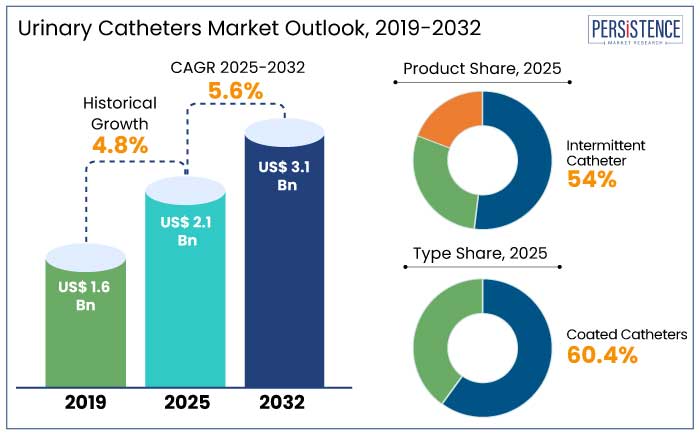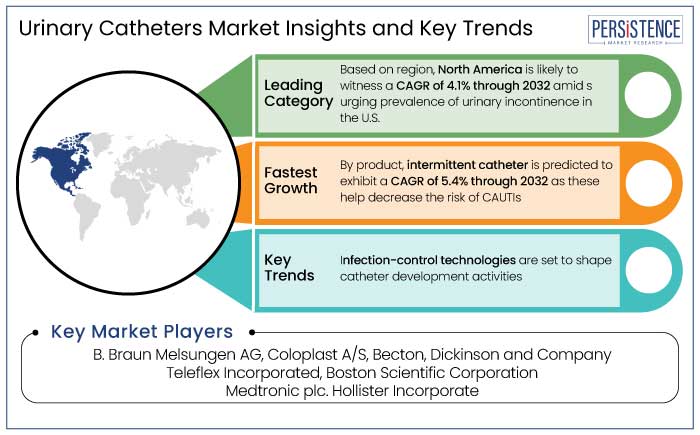ID: PMRREP3268| 180 Pages | 27 Jan 2025 | Format: PDF, Excel, PPT* | Healthcare

The global urinary catheters market is predicted to reach a size of US$ 2.1 Bn by 2025. It is anticipated to witness a CAGR of 5.6% during the forecast period to attain a value of US$ 3.1 Bn by 2032.
According to the National Institute of Diabetes and Digestive and Kidney Diseases (NIDDK), around 25% of adults aged 65 and above experience urinary incontinence, leading to a rising need for urinary catheters. Aging population is a significant contributor to growth of the urinary catheter industry. Rise in home healthcare services is bolstering demand for user friendly and portable urinary catheter solutions.
Patients managing chronic conditions prefer self-catheterization, leading to popularity of intermittent urinary catheters. Antimicrobial catheters are witnessing rising demand as they reduce the risk of catheter associated urinary tract infections (CAUTIs). Studies indicate that antimicrobial catheters can decrease infection rates by 30% compared to standard catheters.

Key Highlights of the Industry
|
Market Attributes |
Key Insights |
|
Urinary Catheters Market Size (2025E) |
US$ 2.1 Bn |
|
Projected Market Value (2032F) |
US$ 3.1 Bn |
|
Global Market Growth Rate (CAGR 2025 to 2032) |
5.6% |
|
Historical Market Growth Rate (CAGR 2019 to 2023) |
4.8% |
North America urinary catheters market is estimated to hold a share of 38.7% in 2025 and witness a CAGR of 4.1% through 2032. Urological conditions like urinary retention, incontinence, and bladder dysfunction are highly prevalent in the region. For example,
The aging population of the region is particularly affected with over 30% of men and women aged 65 and above predicted to have some form of urinary incontinence. This fuels the need for intermittent and indwelling catheters.
Older adults are predicted to require long-term catheterization, supporting the growth of urinary catheter market in the region. Availability of skilled healthcare professionals in the region ensures the widespread adoption of catheters in hospitals and clinics.
Intermittent catheter is anticipated to hold a share of 54% in 2025. These catheters are designed for temporary use, thereby minimizing the risk of catheter associated urinary tract infections (CAUTIs).
Hospitals and healthcare providers recommend intermittent catheterization as a safer alternative, driving the demand for clinical and home care settings. Intermittent catheters are user-friendly and designed for self-catheterization, making these ideal for patients managing chronic conditions at home. For instance,
Coated catheters are projected to account for a share of 60.4% in 2025. Coated catheters, like antimicrobial-coated and hydrophilic-coated types, lower the risk of infections compared to uncoated catheters. For example,
Antimicrobial coatings prevent bacterial adhesion, while hydrophilic coatings decrease friction, lowering irritation and infection risk. Hydrophilic-coated catheters feature a lubricating layer activated by water, minimizing friction during insertion and removal. This makes them particularly suitable for patients requiring frequent catheterization. For instance,
Potential growth in the global urinary catheters industry is predicted to be driven by an emphasis on user-friendly designs and compact products for home based. Smart catheters with IoT enabled monitoring are likely to gain traction in hospitals as well as home care settings. Manufacturers are set to invest in biodegradable and environmentally friendly catheter materials to align with global sustainability goals.

The urinary catheters market growth was steady at a CAGR of 4.8% during the historical period from 2019 to 2023. Increased awareness and improved healthcare access in developed as well as emerging markets drove growth. For example,
Growing geriatric population in North America, Europe, and Asia Pacific fueled demand for urinary catheters as older adults are more prone to blood-related conditions. A shift toward self-catheterization for managing chronic conditions contributed to expansion.
Growth during the forecast period is likely to be driven by rising adoption of novel technologies in the field. Development of healthcare infrastructure in emerging markets is likely to augment demand.
Increased Focus on Homebased Care
Conditions like urinary incontinence, neurogenic bladder, and benign prostatic hyperplasia (BPH) often require long term management using urinary catheters. For example,
Self-catheterization has become a popular option for patients requiring intermittent catheterization owing to convenience and cost-effectiveness. Innovations like hydrophilic coated catheters are easy to use and decrease discomfort, boosting their adoption in home settings. For instance,
Favorable Reimbursement Policies
Several countries include intermittent, indwelling, and external urinary catheters in their healthcare reimbursement frameworks. This ensures that patients can access necessary products without incurring substantial out-of-pocket expenses. For example,
Coverage includes 200 catheters per month for eligible patients. Catheters with sterile packaging or coatings are also reimbursable if deemed medically necessary. For example,
High Cost of Innovative Catheters
Cost of unique catheters, like hydrophilic-coated, antimicrobial-coated, and silicone catheters, is higher than traditional catheters. This makes them less accessible in regions with budget constraints, like in emerging economies or underfunded healthcare systems. For example,
High cost of these products is likely to limit their widespread adoption, especially in cost-sensitive markets.
Awareness Campaigns and Educational Initiatives
Campaigns focusing on conditions like urinary incontinence, neurogenic bladder, and prostate issues are educating the public on the importance of timely diagnosis and management. Manufacturers and healthcare providers are organizing workshops, webinars, and tutorials to train patients and caregivers in proper catheter usage. For example,
Initiatives targeting healthcare professionals ensure they are equipped to guide patients in choosing the right type of catheter and provide training on its proper use. Training programs also emphasize infection control practices to decrease catheter-associated urinary tract infections (CAUTIs).
Increasing Focus on Infection Prevention
Catheter-associated UTIs are among the most common healthcare associated infections across the globe. For instance,
The CDC also estimated that 12% to 16% of adult hospitals inpatients will require a urinary catheter during their stay, thereby increasing the risk of infection. In several countries, hospitals may face penalties or decreased reimbursements for avoidable CAUTIs in several countries. For instance,
Companies in the urinary catheters market are focusing on the development of high-performance catheters that offer additional benefits. These features decrease infection risks while improving patient comfort.
Businesses are offering customized solutions to cater to specific requirements. This ensures consumers have a range of choices, thereby increasing satisfaction and demand.
Manufacturers are focusing on disposable catheters owing to the rising need for single use products that decrease the risk of infections. They are focusing on continuous product development of disposable urinary catheters that offer high comfort while decreasing the risk of cross contamination.
Companies are broadening their product portfolio beyond urinary catheters to include complementary products. This includes catheter insertion kits, urinary drainage bags, and continence care products.
Recent Industry Developments
The market is anticipated to reach a value of US$ 3.1 Bn by 2032.
Intermittent, indwelling (foley), and external catheter are the three types.
North America is anticipated to emerge as the leading region with a share of 38.7% in 2025.
Prominent players in the market include B. Braun Melsungen AG, Coloplast A/S, and Becton, Dickinson and Company.
The market is predicted to witness a CAGR of 5.6% throughout the forecast period.
|
Attributes |
Detail |
|
Forecast Period |
2025 to 2032 |
|
Historical Data Available for |
2019 to 2023 |
|
Market Analysis |
US$ Billion for Value |
|
Key Regions Covered |
|
|
Key Market Segments Covered |
|
|
Key Companies Profiled in the Report |
|
|
Report Coverage |
|
|
Customization and Pricing |
Available upon request |
By Product
By Type
By Application
By End User
By Region
Delivery Timelines
For more information on this report and its delivery timelines please get in touch with our sales team.
About Author